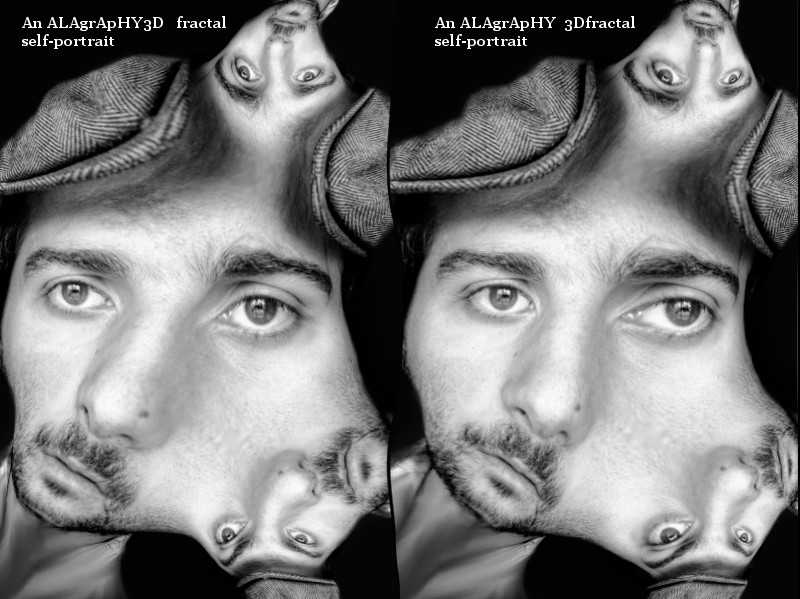3D fractal self-portrait of ALAgrApHY
Photonologie, ou l'etude des photons, explore le nouveau monde de la photographie. Photonology, or the study of photons, explores the new world of photography.
Monday, January 16, 2012
Invitation to the unearthly 3rd Dimension
Dear fellow earthlings,
I invite you to travel with me to the most unearthly corners of my imagination.
Fasten your seat-belts and 3D glasses or simply cross your eyes to fathom the depths of the unimaginable.
"Mon enfant, ma soeur, Songe à la douceur. D'aller là-bas vivre ensemble! Aimer à loisir, Aimer et mourir. Au pays qui te ressemble!" -- C. Baudelaire.
Bon voyage!
Monday, January 2, 2012
3D IR
Have you every seen Infrared with your naked eyes?
Here is your chance through the first infrared video in 3D. Enjoy it in HD!
Here is your chance through the first infrared video in 3D. Enjoy it in HD!
Labels:
3d,
720,
cross-eye,
filter,
infrared,
infrarosso,
infrarouge,
ir,
ir72,
stereo,
stereoscopy,
surreal,
unearthly,
unreal,
unworldly,
video
Wednesday, March 30, 2011
3D Stereo Areal View of Coastal Mexico

Original and Prints at 3D Seascape by =alahay on deviantART
In order to see this in 3D cross your eyes such that the two images overlap in a third central image which will be in 3D having the clouds protruding outside the screen. Let me know if you can or cannot see it.
Areal view of coastal Mexico. I did not invent 3D stereoscopy but my contribution is a rare 3D perspective of coastal mexico that was nontrivial in terms of timing the two frames.
I AM COMPLEX, A FRACTAL SELF-PORTRAIT
Fractal Self-portrait
Music by Neelix (Same but Different)
http://www.facebook.com/alagraphy
Friday, November 26, 2010
IRgraphy
Last week I thought of a very affordable and elegant technique for painting in 3D space with infrared technology.
You only need the following items:
You only need the following items:
- Digital (preferable with liveview) or Film Camera. You must check if your sensor can detect infrared; To do so, just flash any remote control towards the camera and you should see the invisible IR light on the LCD of your camera.
- Any remote control -- I am sure you have one at home, if not, get any universal one ($5-$25)
- Any Infrared filter that fits your camera. I recommend the r72 filter that allows IR spectra beyond 720nm. Most remote control IR wavelengths range between 920nm and 960nm. You can find filters online ($20-$75) or you can build your own cheap IR filter with red and blue transparent plastic or glass sheets but I recommend the former for better quality.
Now, you need to set your camera to manual and set the shutter speed to at least 5 seconds to give you time to paint. Turn the shutter and start painting with your remote control pointing towards the camera lens. I anticipate some examples made using the technique detailed above using a Pentax k-x and a 50mm lens:
EDIT: The first image (above) was featured as a daily deviation on www.deviantart.com for the innovation in manipulation-free photography. So far it has been downloaded 600 times, viewed 6000 times and faved 900 times (03/30/11).
Sunday, November 21, 2010
SLR + InfraRed Filter
Eventually you will get bored of shooting landscapes and portraits until you can afford a lens upgrade, a trip to a remote place or find a new inspiration.
A very affordable ($10-$50) change of perspective can solve your problem and get you inspired for weeks if you are up to the aesthetical challenge. An infrared filter allows into your camera's sensor only photons traveling with long wavelengths, mainly above 700nm. The most common and recommended filter is the R72, which filters light waves above 720nm. Infrared filters are known to add an eerie yet dreamy feel to your pictures as illustrated below (using R72).
Infrared cameras are very sensitive to light, whereas more commercial SLRs need to be adjusted in order to see through the almost opaque infrared filters. Personally, I adjust the exposure to +4 EVs (about 16x slower shutter speed or faster lens) when using the filter and I use a white balance that is similar to that of indoor yellow light. State of art in lens production becomes a ball in the ISO's park with the inevitable noise for action shots or hand-held cameras (in contrast to using a tripod). I resort to ISO 1600 or 3200 when tripod-less.
With IR, any regular place can be turned into heaven with some skills and composition. Lamentably, the latter is not an easy game with a quasi-opaque filter. Therefore, you can either shoot blindly and then get feedback through the playback or you can compose without the IR and then attach it when done composing.
I hope you enjoyed this trip along with the slower photons. Bon voyage!
Subscribe to:
Posts (Atom)







